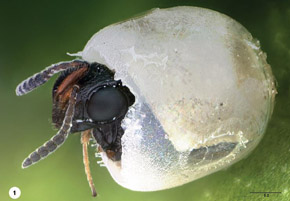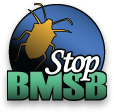Asian Wasp, Enemy of Stink Bugs, Found in the United States
 |
|
One of the recovered Beltsville specimens of Trissolcus japonicus emerges from a BMSB egg. Source: Elijah Talamas, USDA Agricultural Research Service, Systematic Entomology Laboratory |
The Asian wasp Trissolcus japonicus has been found in the wild in the United States. The wasp, native to the regions of Asia where the brown marmorated stink bug (BMSB) originates, is known to attack the eggs of BMSB and possibly other stink bugs. The wasp doesn’t sting or otherwise harm humans, but scientists are working to determine how it might affect stink bugs of all kinds. Kim Hoelmer, an entomologist with the USDA Agricultural Research Service, wrote:
“A survey of resident egg parasitoids of the brown marmorated stink bug, Halyomorpha halys, conducted during the summer of 2014 by Megan Herlihy and Don Weber (ARS-Beltsville Area Research Center, or BARC) using sentinel stink bug egg masses revealed that an Asian egg parasitoid of BMSB, Trissolcus japonicus, was present in the wild at one of his study sites at BARC in Beltsville, Maryland. The specimens were identified by Dr. Elijah Talamas (ARS, Systematic Entomology Laboratory, or SEL), a specialist on this group of parasitoids. We have complete confidence in his identifications. The identification was confirmed by Dr. Matt Buffington (also ARS-SEL) using genomic DNA. The ‘barcode’ regions COI and ITS2 of the BARC specimens were consistent with those of Asian populations of T. japonicus obtained from ARS and CABI-Bioscience field collections in Asia and analyzed by Dr. M.C. Bon at the ARS European Biological Control Laboratory.
Trissolcus japonicus has been under study in U.S. quarantine facilities since 2007 following ARS foreign exploration and imported under APHIS permit, to evaluate its efficacy as a candidate classical biological control agent for BMSB and its host specificity with regard to the stink bug fauna native to the United States. Although many stink bugs are phytophagous pests, some stink bugs are predators and are therefore regarded as beneficial because they often feed on other insect pests. Our research conducted to date indicates that T. japonicus can attack and develop on some non-target stink bug species to varying degrees in no-choice and choice laboratory tests. However, BMSB is the preferred host based on higher parasitism rates. Further studies are in progress to examine the influence of environment (e.g., host habitat) and parasitoid behavior on host selection of non-target species to better understand the likely impact of T. japonicus.
All of the T. japonicus recovered at BARC were found in a wooded habitat in parasitized BMSB egg masses collected from July through September of 2014. In contrast, egg masses placed in nearby soybean fields and an abandoned apple orchard at BARC showed no sign of T. japonicus parasitism. Two other nearby ARS studies in vegetable crops at BARC and in woody ornamentals at the US National Arboretum in D.C. (13 km south of BARC) showed no sign of T. japonicus. At the ARS lab in Newark, Delaware, we have examined numerous specimens from studies in seven surrounding states and none of these samples contained any T. japonicus. Thus, we think this population has probably been detected at an early stage.
How T. japonicus came to the Beltsville site is unknown and is presumed accidental. There are no research cooperators working with live Asian Trissolcus at Beltsville. It is quite possible that parasitized stink bug egg masses (which could have been either BMSB or other Asian stink bug hosts) arrived with foliage of live plants imported to the U.S. Adult Trissolcus wasps are capable of living for several months, so it is also possible they arrived as ‘hitchhiking’ adults.
We plan to conduct surveys this coming field season to see whether T. japonicus survived the winter at the BARC site, and determine the extent of the population in the region. We are also examining the 2014 specimens using microsatellite DNA, which is sensitive enough to distinguish among different geographic populations of the species, to glean additional information on their geographic origin in Asia.”
StopBMSB.org provides information about our team's efforts to control brown marmorated stink bug (BMSB), through funds provided by the USDA's Specialty Crop Research Initiative. If republishing our news, please acknowledge the source ("From StopBMSB.org") along with a link to our website.
